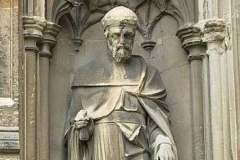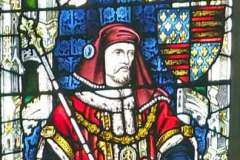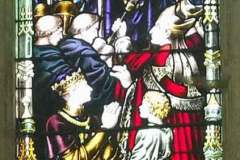(1366-1413) Usurper King and the only Sovereign to be buried in Canterbury Cathedral
Henry was known as Henry Bolingbroke from his birthplace in Lincolnshire. His father , John of Gaunt, was the third surviving son of Edward III, whilst his mother, Blanche of Lancaster, was great-great-granddaughter to Henry III. Despite this royal parentage, Henry’s claim to the throne when he overthrew his cousin Richard II was weak. Returning to England in 1399 after a year’s exile in France, he headed a revolt against his cousin and, with the backing of Parliament, took the throne at the age of 33. His coronation speech in October 1399 was the first since the Norman Conquest to be given in English rather than French. What followed was a decade of unrest and rebellion, including the revolt of Owen Glendower in north Wales. Henry’s final years were blighted by poor health, in particular a persistent skin condition of uncertain origin – described variously as leprosy or even syphilis – and what appear to have been minor strokes. For more on his family, death and burial see the entry on his tomb
What to see:
- Henry IV’s statue on the south face of the tower buttress – this is one of over 60 statues by Theodore Phyffer (Image 1)
- image of Henry IV in the Chapter House east window – note the small representation of his tomb in the lower left corner (Image 2)
- image of the funeral ceremony of Henry IV in the Chapter House west window – depicts Trinity Chapel on Trinity Sunday 1413 (Image 3)
Sources: see standard cathedral sources
NOTE: to hear a Cathedral Podcast on the tomb of Henry IV click here



